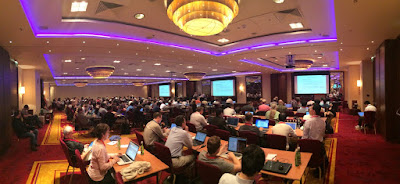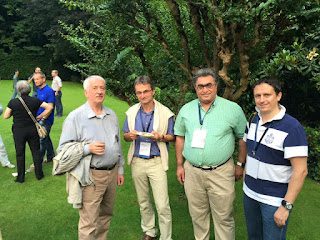MPEG Workshop on 5-Year Roadmap Successfully Held in Chengdu
Chengdu, China – The 116th MPEG meeting was held in Chengdu, China, from 17 – 21 October 2016
MPEG Workshop on 5-Year Roadmap Successfully Held in Chengdu
At its 116th meeting, MPEG successfully organised a workshop on its 5-year standardisation roadmap. Various industry representatives presented their views and reflected on the need for standards for new services and applications, specifically in the area of immersive media. The results of the workshop (roadmap, presentations) and the planned phases for the standardisation of “immersive media” are available at http://mpeg.chiariglione.org/. A follow-up workshop will be held on 18 January 2017 in Geneva, co-located with the 117th MPEG meeting. The workshop is open to all interested parties and free of charge. Details on the program and registration will be available at http://mpeg.chiariglione.org/.
Summary of the “Survey on Virtual Reality”
At its 115th meeting, MPEG established an ad-hoc group on virtual reality which conducted a survey on virtual reality with relevant stakeholders in this domain. The feedback from this survey has been provided as input for the 116th MPEG meeting where the results have been evaluated. Based on these results, MPEG aligned its standardisation timeline with the expected deployment timelines for 360-degree video and virtual reality services. An initial specification for 360-degree video and virtual reality services will be ready by the end of 2017 and is referred to as the Omnidirectional Media Application Format (OMAF; MPEG-A Part 20, ISO/IEC 23000-20). A standard addressing audio and video coding for 6 degrees of freedom where users can freely move around is on MPEG’s 5-year roadmap. The summary of the survey on virtual reality is available at http://mpeg.chiariglione.org/.
MPEG and ISO/TC 276/WG 5 have collected and evaluated the answers to the Genomic Information Compression and Storage joint Call for Proposals
At its 115th meeting, MPEG issued a Call for Proposals (CfP) for Genomic Information Compression and Storage in conjunction with the working group for standardisation of data processing and integration of the ISO Technical Committee for biotechnology standards (ISO/TC 276/WG5). The call sought submissions of technologies that can provide efficient compression of genomic data and metadata for storage and processing applications. During the 116th MPEG meeting, responses to this CfP have been collected and evaluated by a joint ad-hoc group of both working groups, comprising twelve distinct technologies submitted. An initial assessment of the performance of the best eleven solutions for the different categories reported compression factors ranging from 8 to 58 for the different classes of data.
The submitted twelve technologies show consistent improvements versus the results assessed as an answer to the Call for Evidence in February 2016. Further improvements of the technologies under consideration are expected with the first phase of core experiments that has been defined at the 116th MPEG meeting. The open core experiments process planned in the next 12 months will address multiple, independent, directly comparable rigorous experiments performed by independent entities to determine the specific merit of each technology and their mutual integration into a single solution for standardisation. The core experiment process will consider submitted technologies as well as new solutions in the scope of each specific core experiment. The final inclusion of submitted technologies into the standard will be based on the experimental comparison of performance, as well as on the validation of requirements and inclusion of essential metadata describing the context of the sequence data, and will be reached by consensus within and across both committees.
Call for Proposals: Internet of Media Things and Wearables (IoMT&W)
At its 116th meeting, MPEG issued a Call for Proposals (CfP) for Internet of Media Things and Wearables (see http://mpeg.chiariglione.org/), motivated by the understanding that more than half of major new business processes and systems will incorporate some element of the Internet of Things (IoT) by 2020. Therefore, the CfP seeks submissions of protocols and data representation enabling dynamic discovery of media things and media wearables. A standard in this space will facilitate the large-scale deployment of complex media systems that can exchange data in an interoperable way between media things and media wearables.
MPEG-DASH Amendment with Media Presentation Description Chaining and Pre-Selection of Adaptation Sets
At its 116th MPEG meeting, a new amendment for MPEG-DASH reached the final stage of Final Draft Amendment (ISO/IEC 23009-1:2014 FDAM 4). This amendment includes several technologies useful for industry practices of adaptive media presentation delivery. For example, the media presentation description (MPD) can be daisy chained to simplify implementation of pre-roll ads in cases of targeted dynamic advertising for live linear services. Additionally, support for pre-selection in order to signal suitable combinations of audio elements that are offered in different adaptation sets is enabled by this amendment. As there have been several amendments and corrigenda produced, this amendment will be published as a part of the 3rd edition of ISO/IEC 23009-1 together with the amendments and corrigenda approved after the 2nd edition.
How to contact MPEG, learn more, and find other MPEG facts
To learn about MPEG basics, discover how to participate in the committee, or find out more about the array of technologies developed or currently under development by MPEG, visit MPEG’s home page at http://mpeg.chiariglione.org. There you will find information publicly available from MPEG experts past and present including tutorials, white papers, vision documents, and requirements under consideration for new standards efforts. You can also find useful information in many public documents by using the search window.
Examples of tutorials that can be found on the MPEG homepage include tutorials for: High Efficiency Video Coding, Advanced Audio Coding, Universal Speech and Audio Coding, and DASH to name a few. A rich repository of white papers can also be found and continues to grow. You can find these papers and tutorials for many of MPEG’s standards freely available. Press releases from previous MPEG meetings are also available. Journalists that wish to receive MPEG Press Releases by email should contact Dr. Christian Timmerer at christian.timmerer@itec.uni-klu.ac.at or christian.timmerer@bitmovin.com.
Further Information
Future MPEG meetings are planned as follows:
No. 117, Geneva, CH, 16 – 20 January, 2017
No. 118, Hobart, AU, 03 – 07 April, 2017
No. 119, Torino, IT, 17 – 21 July, 2017
No. 120, Macau, CN, 23 – 27 October 2017
For further information about MPEG, please contact:
Dr. Leonardo Chiariglione (Convenor of MPEG, Italy)
Via Borgionera, 103
10040 Villar Dora (TO), Italy
Tel: +39 011 935 04 61
leonardo@chiariglione.org
or
Priv.-Doz. Dr. Christian Timmerer
Alpen-Adria-Universität Klagenfurt | Bitmovin Inc.
9020 Klagenfurt am Wörthersee, Austria, Europe
Tel: +43 463 2700 3621
Email: christian.timmerer@itec.aau.at | christian.timmerer@bitmovin.com

















